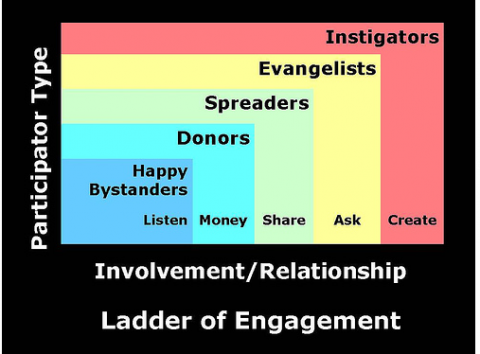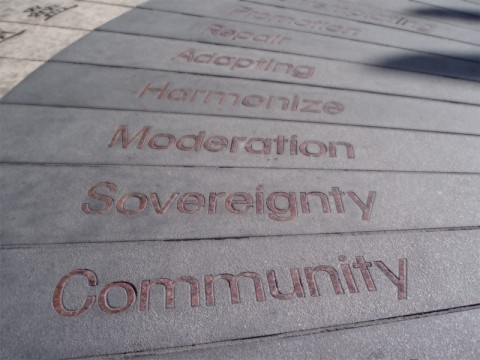Archives
February 14, 2011

Photo by: Trizzie2006
We at IISC are big fans of the work of John McKnight and Peter Block, some of us even have some bones to pick with them – but that’s the best sign of admiration! In this blog post, originally appearing in the Huffington Post they bring a very different and appreciated perspective.
Read More
February 11, 2011
 Photo by: Carija
Photo by: Carija
The following is a post by Steve Waddell in NetDev….
Last week I presented maps for a Renew Boston (RB) group. Although the maps are preliminary, they provide a good illustration of how the two methodologies used can be complementary. They present a nice case study about use of maps.
Why map? Here’re the reasons I give:
- To “see” the whole “change field”…rather than limited individual perspectives
- To create collective visions and theories of change
- To understand current relationships and how work is currently done
- To understand how relationships/work flows should change
- Define implications of changes to identify key leverage points for optimal influence and conflicts, synergies and gaps
Read More
February 10, 2011

|Photo by Sebastian-Dario|http://www.flickr.com/photos/sebastian-silva/2207382770|
Paola Antonelli has appeared in various posts on this blog over the past couple of years as one of our favorite purveyors of design thinking and its application to social change. Now Antonelli is really stepping out. In an article for SEED Magazine, the senior curator of Design and Architecture at the Museum of Modern Art holds out a whole new and exciting realm of application for design – policymaking, governance, and social agendas. Read More
February 9, 2011

|Photo by Vvillamon|http://www.flickr.com/photos/villamon/4468869725|
In a recent article in Administration and Society, Sonia M. Ospina and Angel Saz-Carranza consider how it is that leadership in multi-organizational networks carries out vital balancing acts. On the one hand, they consider ways to navigate the internal tension between creating unity and honoring diversity among stakeholders. On the other hand, they look at how the balance is struck between confrontation and dialogue when doing outward-facing work. The source of their insights are the experiences of two urban immigration coalitions in the United States.
By way of summary, to successfully address paradox in the context of balancing unity and diversity inside the network, Ospina and Saz-Carranza observed leadership doing the following: Read More
February 8, 2011
I’m keen on developmental theory. And I’m particularly interested in the implications of the Wilber-Combs Lattice. I don’t want to distract you with the esoteric, but I do think the picture is worth including.

The most important contribution of the Wilber-Combs Lattice is the distinction between states and stages. Stages (vertical axis) are developmental – they are sequential, you can’t skip through them and they progressively transcend and include each other. States (horizontal axis) on the other hand, are available to all stages.
What does this all mean? Read More
February 7, 2011
 Photo by: Fzyaso
Photo by: Fzyaso
The following is a repost of a Huffington Post blog by Alicia Anstead, including reference to the work of IISC’s own Melinda Weekes.
Tonye Patano, a black actor in New York City, was so consumed last year by reading a script about minstrelsy, she was late for an audition. The story had rattled and repulsed her. But she couldn’t put it down. The day when she finally headed to the audition, she heard a group of young black teens on the street riffing in racially charged language.
“It was their way of relating to each other,” said Patano. “My response in my spirit was: ‘Young man, do you hear what you’re saying?’ But they were owning who they were, not caring about anyone’s judgment. Even if I don’t agree with it, they had made the language their own.”
Read More
February 4, 2011

“How do societies create the breakthroughs needed for a more just, tolerant, healthy, educated, and equitable world? How do they challenge the prevailing wisdom without losing hope? How do they enact lasting change and protect it from the inevitable backlash?” This age-old question is subject of Paul Light’s new book, Driving Social Change, from John Wiley & Sons publishers. The Nonprofit Quarterly features a summary of the book in their most recent issue.
Read More
February 3, 2011

“It’s hard to make a difference when everyone is tangled up in the rigging of procedural formality and blanketed in fog.”
-Roberta’s Rules of Order
With all of the snow days we’ve had so far in 2011, you’ll understand if I begin this post from a “when things don’t go according to plan” mindset. We’ve all taken our lumps in doing collaborative work, even with the best laid plans and best intentions in place. I’ve had the opportunity to do a little reflecting (in between tours of duty shoveling) on what has made for more successful and less successful collaborative endeavors, and here are some of the important lessons I’ve learned when things have not gone as well as had been hoped for: Read More
February 2, 2011

|Image from cambodia4kidsorg|http://www.flickr.com/photos/cambodia4kidsorg/2296887265|
I’ve been working with a couple of organizations and initiatives lately as they discuss enhancing their strategies for stakeholder engagement. Throughout all of this work is the emerging awareness that we are in the midst of a paradigm shift in our field with respect to what engagement means and looks like. This, of course, has been captured by many writers and thinkers who have been looking closely at what social media is enabling (see, for example, Clay Shirky’s work, the Working Wikkily blog, or the writings of Beth Kanter and Allison Fine). And at the same time there is a realization that this is not just about technology, but a return to some of what we’ve forgotten as well as a step towards something new. Read More
January 31, 2011
 Photo by: Dionyziz
Photo by: Dionyziz
Akaya Windwood, President of the Rockwood Leadership Institute is among the newest members of the IISC Board of Directors, the following are her reflections:
I’ve just about had it with the vitriol and saber-rattling lately. Our world cannot sustain much more bellowing from those on one end of a spectrum at those on the other, with no room for nuance, ambiguity or the unknown. Enough!
So much of our current day “discourse” is framed (at least in the mainstream media) by discussions of who is right/wrong, right/left, bad/good, holy/evil. As long as we are limited to these extremes, we will be doomed to the tyranny of righteousness and posturing. This will not, and cannot, sustain us.
Read More
January 30, 2011

A very interesting thing has been going on in the Development Community. They’re getting it wrong. And while the norm is to hide failures away out of fear and embarrassment – and concern about funding being affected, they’re doing something different. A group of people working in development have just started a new website, called “Admitting Failure” – sharing their failures and trying to build transparency, collaboration and innovation into the development sector. They’re building a shared resource, saying that “the only ‘bad’ failure is one that’s repeated.” Take a look!
January 28, 2011

|Photo by Claus Rebler|http://www.flickr.com/photos/zunami/3160939004|
Peter Block has had considerable influence with a number of us here at IISC through his recent writings – Community: The Structure of Belonging and The Abundant Community. These have inspired me to dip back into some older publications of his, most specifically the wonderful book, The Answer to How is Yes: Acting On What Matters. What I appreciate about this particular work is both its timeliness and his constant reminder that “Transformation comes more from pursuing profound questions than seeking practical answers.” Read More

 Photo by:
Photo by: 


 Photo by:
Photo by: 


 Photo by:
Photo by: 
